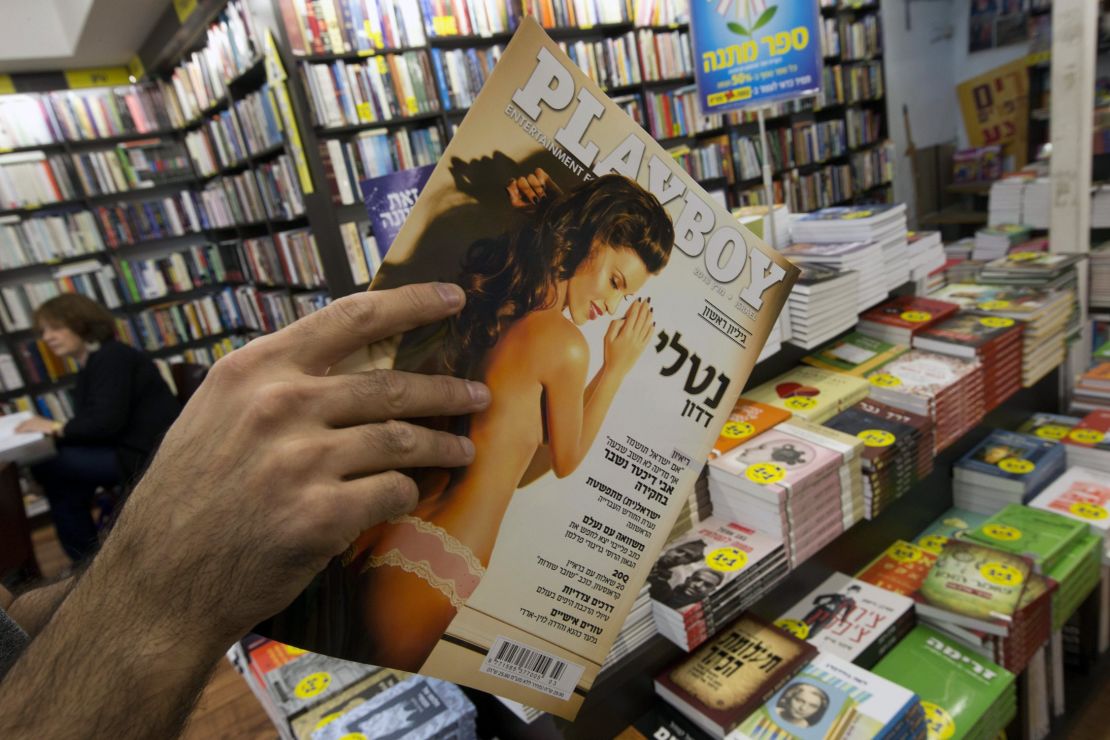Story highlights
March saw the launch of Playboy magazine's first edition in Hebrew
Previous attempts to publish adult magazine in the 1980s were met with hostility
Publisher says he has not seen a bad reaction since launch
Some contend that the magazine is no longer very scandalous and the internet makes it less viable
Playboy magazine recently published its first Hebrew language edition in Israel – but has anyone actually been reading the articles to notice?
According to the publisher of the magazine, launched three months ago with Israeli model Nataly Dadon on the cover and an interview with a former Israeli intelligence chief between the sheets, the country is finally ready for a Hebrew Playboy.
“It’s a time when Israel is really joining the family of modern nations, and Playboy is just part of modern global culture,” says Dan Pomerantz, who emigrated from his native Chicago to Israel 15 months ago.
“The brand has been popular (in Israel) for a long time and a Hebrew language magazine can really reach the entire market, whereas the English language version is really a niche commodity.”
With its third issue about to hit the newsstands, Pomerantz contends that the public are becoming more comfortable with the magazine’s content, while interest from potential advertisers, interview subjects and potential Playboy “bunnies” is growing – the magazine’s website has a form for would-be models to apply.
“So far we haven’t had a negative reaction,” says Pomerantz, who acknowledges that many conservative and ultra-orthodox religious groups would “not want to interact with the brand.”
Read more: Butlers in demand in Gulf states
Earlier attempts to launch adult magazines in Israel met greater opposition.

Galia Albin, the publisher who introduced Penthouse Magazine into the country in 1989, remembers a torrid 11 months before she sold the title. The reaction by religious groups was so fierce that the printing press was threatened with arson.
“It wasn’t easy,” she said. “Good luck to (Playboy), I think they are brave. Israel is open in some ways but in magazines, no.”
Albin admits that she wanted a marketing gimmick that would cause a stir, but maintains that the magazine was introduced for more than just shock value, standing for a more liberal, secular society.
“Back then, secular Jews didn’t think they had rights,” she says.
Some observers believe that reading the Hebrew edition of Playboy could still be seen as political statement.
“Playboy makes a very specific claim,” says Hugo Schwyzer, the American author and commentator on gender studies. “It doesn’t see itself as political, but it is political – it advocates for hedonism and sexual pleasure and the right for women to bare their body in public… Those are deeply political statements in Israel in a way that they are not really political in other countries.”
However, for those on Israel’s liberal left, Playboy’s arrival in Hebrew is more like dusting off a relic from a bygone era.
“If you want nudity, there’s the internet,” says Sarah Tuttle-Singer, a blogger for the Times of Israel.
“I’m not seeing very much fuss (in public about the launch of the magazine). If they wanted to be interesting, they should have women wearing prayer shawls – and only prayer shawls – standing in front of the Kotel (Wailing Wall).
“That might be scandalous, controversial, and at least something that we’ve not seen before. Unless the articles are holding their own merit, I don’t see the interest,” she said , noting that the Hebrew edition’s Facebook page has only around 5,800 “likes.”
Gallery: Dubai’s stunning skyline
Content aside, launching a new print publication, albeit with a well-known brand name, is still something of a business risk, when increasingly people use internet to find whatever they want, mostly for free.
“We don’t see ourselves as a magazine company,” says Pomerantz. “High-quality content is what we provide. We are going to relaunch our website and give our audience a whole other avenue to reach us. What we’ve found is that the printed magazine gives us a certain gravitas.”
From a business standpoint, the launch could be seen as part of the brand’s global strategy to diversify, as its magazine sales have steadily declined since their high point in the 1970s. According to a recent report in the Wall Street Journal, the U.S. print publication loses around $6 million each year and uses licensing to international editions as a way to offset the losses. The familiar bunny logo is now more likely to be seen on clothing, jewelry, luggage or condoms than magazine covers.
For all the potential pitfalls of print publishing and dealing with controversial content, Pomerantz remains bullish about the magazine’s ability to push a few boundaries.
“From the statistics on our website and Facebook, we can tell that a number of our followers are Arab speakers and Palestinians within Israel and neighboring countries,” he says.
“We are looking forward to putting together special content specifically to target the Arab market. We’ve seen so far a real interest that we want to encourage.”
